Week ending 12 September 2020
REGIONAL OVERVIEW
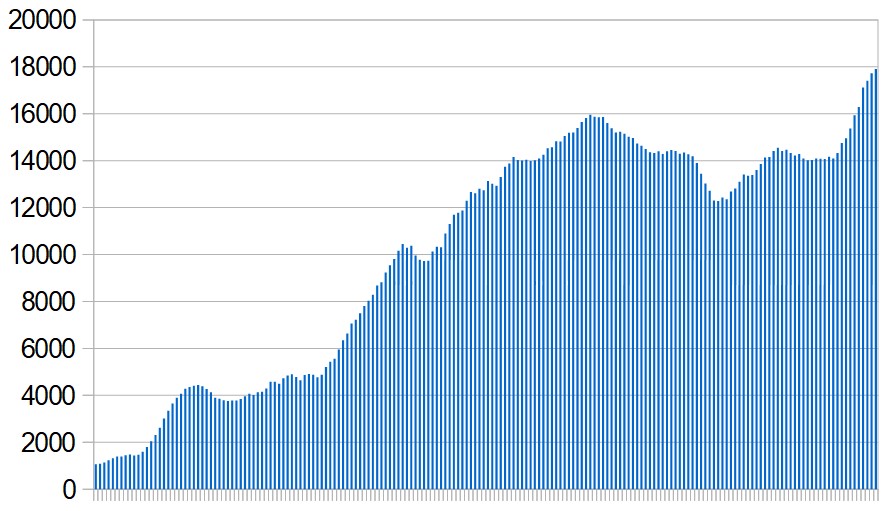 |
Covid-19 infections in the Middle East and North Africa have risen to new heights over the last few days. The total of new cases across the region has averaged almost 18,000 a day this week, according to the official figures.
Iraq continues to report the largest number of new cases and, based on population size, Bahrain and Israel have the highest infection rates.
Most countries in the region took swift action when the virus first arrived and for a while seemed to be having some success in slowing its spread. Six months on, though, many of them are struggling to hold the line, partly because of the economic effects of preventive measures.
Another huge problem, almost everywhere in the region, is non-compliance with preventive measures by large sections of the public and this has wider implications for the relationship between regimes and the people they govern.
Officially-reported death rates remain low, with an average total of 321 deaths per day across the region.
Detailed statistics for the region, based on official figures, can be found in this spreadsheet.
Previous situation reports:
September 5; August 29; August 22; August 15; August 8; August 1; July 25; July 18; July 11; July 4; June 27; June 20.
ALGERIA
Algeria's outbreak peaked towards the end of July when more than 600 new infections were being recorded each day. Since then the trend has been downwards, with new cases averaging 288 a day during the past week according to official figures.
For more information see: Covid-19 in Algeria
Confirmed cases: 47,752
New cases in past week: 2,019
Active cases: 11,975
Deaths: 1,599
Tests carried out: (unknown)
BAHRAIN
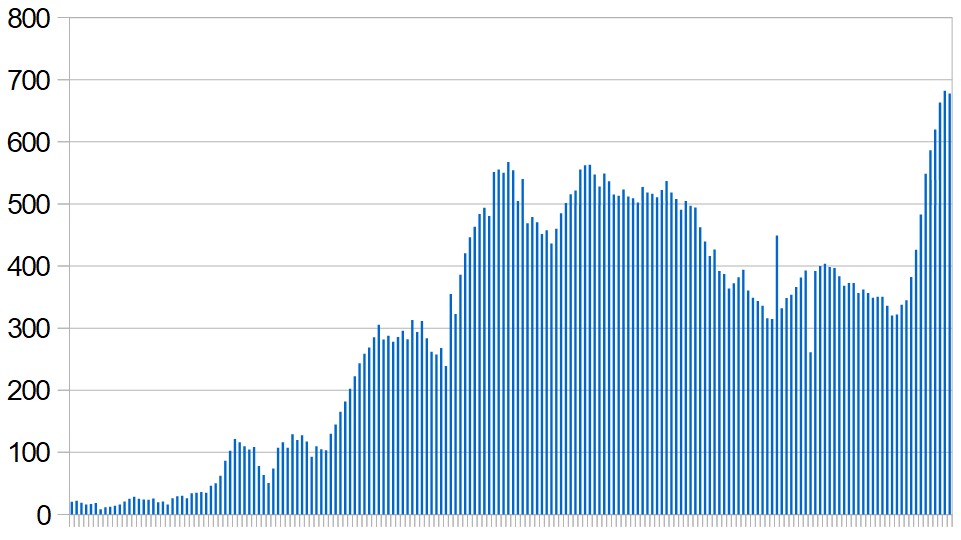 |
Since the outbreak began Bahrain has recorded more than 34,000 cases per million inhabitants. This makes it the world's third most infected country after Qatar and French Guiana.
Currently, Bahrain has the highest infection rate in the Middle East. Its daily average this week was 39 new cases per 100,000 inhabitants.
However, Bahrain is also one of the world leaders in Covid-19 testing. So far, about two-thirds of its 1.7 million population have been tested.
Until recently Bahrain's epidemic appeared to be gradually subsiding but new infections have risen sharply since the beginning of September, averaging 678 a day this week. The daily figure has more than doubled since the end of August and is now at its highest level since the outbreak began.
According to the health ministry contact tracing has shown a strong correlation between "private gatherings" and the increase in infections.
The start of the new school year has been postponed for two weeks. This is reportedly to allow more time for scaling-up coronavirus testing for teachers and administrative staff.
Six thousand people in Bahrain are reported to be taking part in trials of a vaccine on behalf of the Chinese company Sinopharm, and so far there are said to have been no adverse reactions among those vaccinated.
For more information see: Covid-19 in Bahrain
Confirmed cases: 58,839
New cases in past week: 4,744
Active cases: 5,853
Deaths: 208
Tests carried out: 1.2 million
EGYPT
According to the Egyptian authorities, new infections this week averaged 161 a day compared with almost 1,600 a day at the peak in June. The official figures are surprisingly low considering Egypt's large population (103 million) and the often crowded living conditions.
It's also unclear how many tests are being carried out because the government has not issued any figures since May when the total stood at 135,000 tests.
Whether or not the official statistics are true, anecdotal evidence does suggest the number of new cases has dropped considerably and the Egytian Streets website discusses some possible explanations.
School and university classes were suspended last March and the new school year is due to start later than usual, on October 17. The education ministry has now produced detailed plans for the reopening which include reduced attendance at schools coupled with a substantial amount of online learning.
For more information see: Covid-19 in Egypt
Confirmed cases: 100,708
New cases in past week: 1,126
Active cases: 12,628
Deaths: 5,607
Tests carried out: 135,000
IRAN
Iran was the first country in the region to be seriously affected by the virus. Government figures show an initial wave of infections which peaked at the end of March. It subsided during April, briefly dipping below 1,000 new cases per day but then rose to another peak, touching almost 3,000 a day in the first week of June.
Since then there has been some improvement and the current level is around 2,000 a day.
Iran continues to report more coronavirus-related deaths than any other country in the region.
Confirmed cases: 397,801
New cases in past week: 15,029
Active cases: 32,349
Deaths: 22,913
Tests carried out: 3.5 million
IRAQ
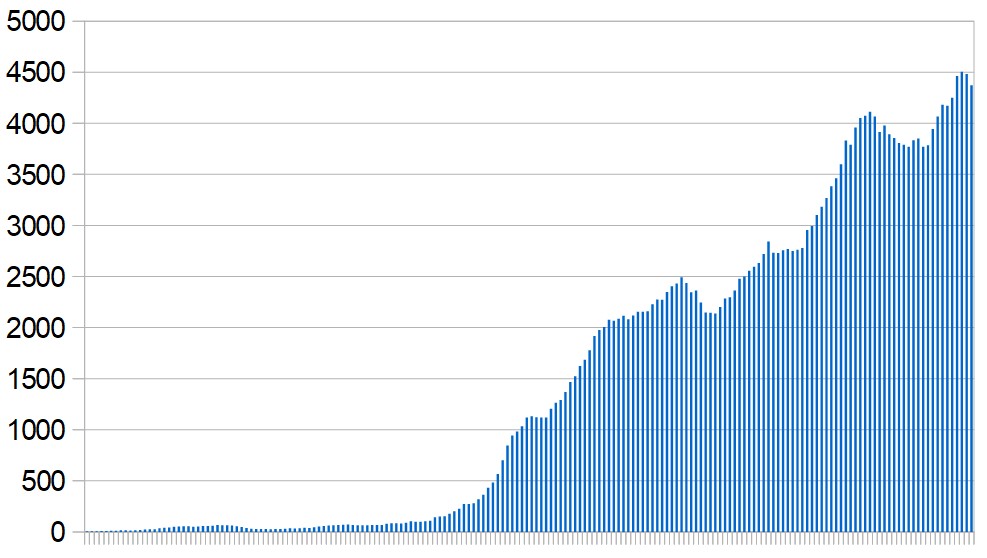 |
Iraq is currently recording more new infections than any other country in the region. New cases this week averaged 4,371 a day.
Iraq's official figures are widely believed to understate the scale of the epidemic. Many cases go unreported because of social stigma. Compliance with preventive measures appears to be low and health services are inadequate.
On Wednesday Iraq's Director of Public Health attributed rising numbers of confirmed cases to higher levels of testing. "The increase in the number of infection cases is due to the increase in the number of tests that reached more than 25 thousand per day," he said.
For more information see: Covid-19 in Iraq
Confirmed cases: 282,672
New cases in past week: 30,597
Active cases: 57,395
Deaths: 7,881
Tests carried out: 1.7 million
ISRAEL
 |
After coming close to bringing the epidemic under control, Israel has been hit by a second wave much larger than the first. The first wave peaked at around 600 new cases a day in early April. Efforts to control it were intially successful and by the second half of May new cases had dropped to about 15 a day.
However, the virus surged back when lockdown restrictions were lifted. New infections this week were the highest so far, averaging 3,164 a day compared with 2,060 during the previous week.
After Bahrain, Israel has the second highest infection rate in the Middle East. Its daily average this week was 33 new cases per 100,000 inhabitants.
On Thursday, Israel's "coronavirus cabinet" took the drastic step of approving plans for a second nationwide lockdown. This will be put to the full cabinet on Sunday.
The lockdown is expected to last for a month, starting in the next few days just before the Rosh Hashanah holiday. The first phase will be the strictest, with Israelis ordered to stay within 500 metres of their homes. Schools and businesses will be closed and most leisure activities will be banned.
If the lockdown goes ahead there is likely to be stiff resistance. The Times of Israel reports that many businesses are threatening to stay open, fearing financial ruin if they have to close again.
For more information see: Covid-19 in Israel
Confirmed cases: 148,564
New cases in past week: 22,145
Active cases: 35,746
Deaths: 1,090
Tests carried out: 2.6 million
JORDAN
For several months Jordan appeared to be the most successful Arab country in controlling the virus. Transmission within Jordan had virtually ceased and almost all the new cases were detected among people arriving from abroad.
Since then, however, community transmission has returned with a spate of locally-occurring infections. Despite that, Jordan's outbreak is still small, with fewer than 3,000 cases confirmed so far.
Until yesterday the daily totals of new infections had not risen above double figures but there was alarming news on Friday when the health ministry announced an unprecedented 206 new cases – of which 197 were locally generated. Most of these were contacts of previously-confirmed cases but there were also 76 in the capital, Amman, where the source of infection is still unknown.
For more information see: Covid-19 in Jordan
Confirmed cases: 2,945
New cases in past week: 644
Active cases: 840
Deaths: 21
Tests carried out: 959,000
KUWAIT
New infections peaked in late May at just over 1,000 cases a day. Although the numbers have dropped back substantially since then, they have been creeping up again over the last few days. This week's average was 747 new cases a day compared with 666 a day during the previous week.
For more information see: Covid-19 in Kuwait
Confirmed cases: 93,475
New cases in past week: 5,232
Active cases: 9,258
Deaths: 557
Tests carried out: 668,000
LEBANON
Political and economic turmoil, plus the devastating explosion in Beirut on August 4, have diverted attention from the coronavirus. Lebanon's outbreak is still relatively small, though the number of confirmed cases has more than trebled during the past month.
The sharp rise during August led to a rather half-hearted two-week lockdown which appears to have brought new infections to a plateau of 500-600 a day.
Dr Firass Abiad, head of the Rafik Hariri University Hospital in Beirut, warned this week that the numbers are unlikely to decline without proper preventive measures. “As universities and schools open, even in a hybrid format, there will be more contact in the community. The virus is still present, and adherence to preventive measures is selective and scant at best,” he said.
For more information see: Covid-19 in Lebanon
Confirmed cases: 22,983
New cases in past week: 3,493
Active cases: 15,442
Deaths: 229
Tests carried out: 630,000
LIBYA
Libya is in its ninth year of internal conflict. The UN-backed Government of National Unity in Tripoli is challenged by Field Marshall Haftar's forces based in the east of the country. There are also numerous militias. This leaves the country ill-equipped to cope with a major epidemic.
Growing levels of insecurity, political fragmentation and weak governance have led to a deterioration of basic services, particularly in the health system. At least 27 health facilities have been damaged or closed by fighting and some have been attacked directly. There are 870,000 people – refugees, asylum seekers and displaced persons – who the UN regards as especially vulnerable.
According to the official figures Libya's outbreak is still relatively small but the total of confirmed Covid-19 cases has more than doubled over the last three weeks. New infections recorded this week averaged 780 a day compared with 545 the week before.
For more information see: Covid-19 in Libya
Confirmed cases: 21,908
New cases in past week: 5,463
Active cases: 19,050
Deaths: 352
Tests carried out: 153,000
MOROCCO
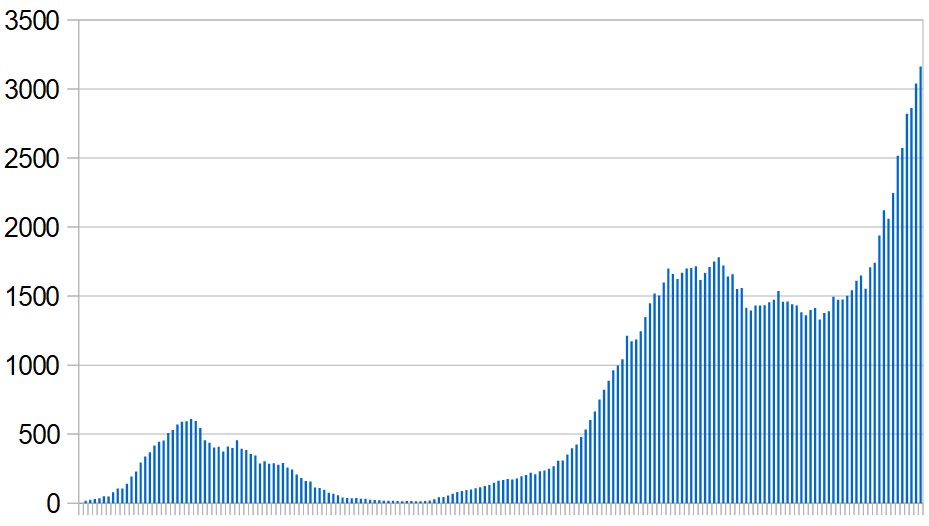 |
By early June a strict lockdown had reduced new cases in Morocco to around 40 a day. Since then, though, there has been a major setback and on Friday a record 2,430 new cases were recorded. Of those, the largest number (895) were in the Casablanca-Settat region.
A seven-hour night curfew has been imposed in Casablanca and schools there – which were about to reopen – have been told to switch to distance learning. Coastal cities have been told to close their beaches.
Morocco has previously had problems with infections in its prisons, and family visits to prisoners have again been suspended.
The health minister warned on Sunday that Morocco could be "overwhelmed" by the virus unless drastic measures were taken but others are warning that another national lockdown would be economically disastrous.
For more information see: Covid-19 in Morocco
Confirmed cases: 82,197
New cases in past week: 13,592
Active cases: 16,479
Deaths: 1,524
Tests carried out: 2.2 million
OMAN
Infections peaked in mid-July with just under 1,600 cases a day but have dropped back considerably since then. The numbers have been relatively stable over the last month and this week's average was 280 new cases a day.
For more information see: Covid-19 in Oman
Confirmed cases: 88,337
New cases in past week: 1,957
Active cases: 4,250
Deaths: 762
Tests carried out: 309,000
PALESTINE
The Palestinian enclave of Gaza is densely populated, with limited medical facilities, and there have long been fears about the likely consequences of a major epidemic. Until recently, however, Gaza had been relatively free of Covid-19, with only 117 confirmed cases.
That changed in the last week of August when 75 new cases were reported and the Hamas authorities imposed a lockdown. Transmission within the community has now clearly taken hold and this week saw a further 934 infections, bringing the total to 1,631.
Meanwhile, the upward trend in the West Bank continues, with 5,460 new cases reported this week. Hebron is the most seriously affected area, accounting for more than 40% of the cases confirmed so far.
Many of the West Bank infections are attributed to people ignoring the rules for social distancing, which the authorities have difficulty enforcing.
For more information see: Covid-19 in Palestine
Confirmed cases: 37,866 (West Bank 27,625, Gaza 1,631, East Jerusalem 8,610)
New cases in past week: 4,890
Active cases: 9,264
Deaths: 232
Tests carried out: 329,000
QATAR
In population terms Qatar has more known cases than any other country – 43,000 per million inhabitants. Migrant workers have been disproportionately affected. Qatar's epidemic reached a peak in the first week of June but infections have fallen since then. New cases this week averaged 236 a day – well below the peak of more than 1,800 a day.
For more information see: Covid-19 in Qatar
Confirmed cases: 121,287
New cases in past week: 1,650
Active cases: 2,883
Deaths: 205
Tests carried out: 681,000
SAUDI ARABIA
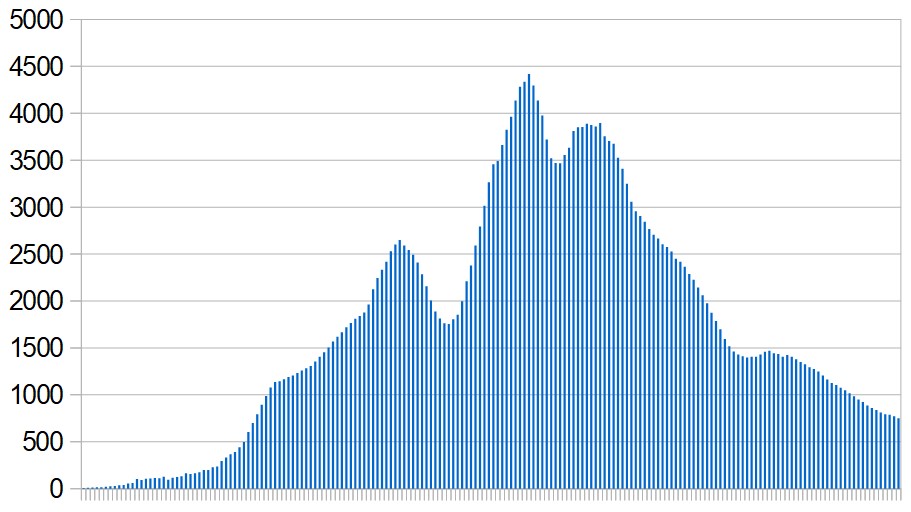 |
Saudi Arabia has the largest number of recorded cases among the Arab countries. New infections reached an initial peak in the fourth week of May, then dropped back slightly before rising to a higher peak in the third week of June. Since then, though, there has been a substantial improvement.
New cases this week averaged 752 a day – the lowest level since April.
For more information see: Covid-19 in Saudi Arabia
Confirmed cases: 324,407
New cases in past week: 5,266
Active cases: 19,261
Deaths: 4,213
Tests carried out: 5.6 million
SUDAN
The coronavirus struck Sudan in the midst of a political transition following a popular uprising against the regime of President Bashir and the country is ill-equipped to cope with a major epidemic. Testing is very limited and official figures don't reflect the full scale of the outbreak. The health ministry appears to have stopped issuing daily reports.
For more information see: Covid-19 in Sudan
Confirmed cases: 13,470
New cases in past week: 281
Active cases: 5,905
Deaths: 834
Tests carried out: (unknown)
SYRIA
According to official figures only 3,476 cases have been recorded in areas controlled by the Assad regime – almost two-thirds of them during the past month.
The authorities' lack of transparency fuels suspicions that many cases are being concealed. There is also some evidence that people with Covid-19 symptoms are reluctant to contact the authorities. While there are plenty of signs that the true figures are higher than those issued by the regime, it is unclear how high they really are.
The UN's Office for the Coordination of Humanitarian Affairs commented on this for the first time in a report issued last week, saying that "the actual number of cases may far exceed official figures".
On Monday, perhaps in response to the UN report, the government news agency published an unusually long article reporting a decrease in the number of Covid-19 patients being admitted to hospitals.
Fears have been raised about north-western and north-eastern parts of the country which are outside the regime's control. Millions of displaced people are living in those areas and health services are often rudimentary. So far, though, the number of confirmed infections remains fairly small. The latest figures are 704 known cases in the north-east and 112 in the north-west.
For more information see: Covid-19 in Syria
The following figures relate to regime-controlled areas only:
Confirmed cases: 3,476
New cases in past week: 435
Active cases: 2,514
Deaths: 150
Tests carried out: 26,572 (by 24 August)
TUNISIA
In June, Tunisia appeared to be almost free of the virus and began promoting itself as a safe holiday destination. Since then, though, there has been a setback.
Tunisia's outbreak remains small but the number of new cases continues to rise. This week's average of 245 a day was the highest so far.
For more information see: Covid-19 in Tunisia
Confirmed cases: 6,259
New cases in past week: 1,717
Active cases: 4,200
Deaths: 103
Tests carried out: 168,000
UNITED ARAB EMIRATES
The UAE's epidemic peaked in the last week of May when new infections were running at more than 900 a day. Numbers of new cases are now considerably lower, though they have been rising again recently. This week's average of 725 a day is the highest for more than three months.
The UAE has carried out more tests per head of population than any other Arab country and ranks tenth worldwide in terms of tests carried out.
For more information see: Covid-19 in the UAE
Confirmed cases: 77,842
New cases in past week: 5,076
Active cases: 8,982
Deaths: 398
Tests carried out: 8 million
YEMEN
Because of the ongoing war, Yemen already faced a humanitarian crisis before the coronavirus arrived. Millions are malnourished and vulnerable to disease, and health services are inadequate. Official figures grossly understate the severity of the epidemic. Cholera is also prevalent.
For more information see: Covid-19 in Yemen
Confirmed cases: 2,011
New cases in past week: 24
Active cases: 214
Deaths: 583
Tests carried out: (unknown)

 RSS Feed
RSS Feed
